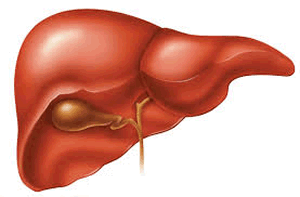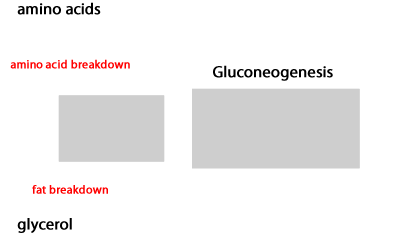Gluconeogenesis
Gluconeogenesis is a metabolic process that results in the synthesis of glucose from non-carbohydrates such as amino acids and glycerol from fats. It occurs primarily in the liver and to a lesser extent in the kidney. Carbon substrates for gluconeogenesis include pyruvate, glycerol and lactate. Gluconeogenesis is one of two pathways that the body uses to control blood sugar levels. Gluconeogenesis provides an avenue to controlling blood sugar levels during times of extreme stress, as occurs during starvation. Glycogenolysis, however, is the breakdown of glycogen into glucose by the liver and forms the second pathway animals use to controlling blood sugar.
The source of substrates, such as pyruvate, for gluconeogenesis comes mainly from amino acid breakdown (catabolism). During carbohydrate fasting or starvation, proteins in muscle tissue may break down to supply the required amino acids. These amino acids are transported to the liver where they are deaminated and become precursors for gluconeogenesis. Glycerol, another input for gluconeogenesis, is sourced from the hydrolysis of triglycerides present in fat cell.


A simplified depiction of gluconeogenesis is shown on the left.
In the production of pyruvate, from amino acid breakdown, the liver must deaminate amino acid molecules, in other words remove the amine group (NH3+). NH3 is extremely toxic and must be removed from the body, it is therefore convertedby the liver into urea, which is less toxic, and removed by the kidneys.
1) Which of the following, regarding nucleogenesis, are incorrect?
a) Nucleogenesis turns protein into glucose.
b) Nucleogenesis uses carbon skeletons of molecules derived from amino acid and fat breakdown to produce glucose.
c) Nucleogenesis takes place in brain cell as the brain is the only organ int he body that uses only glucose as a fuel.
d) Nucleogenesis does not require energy as an input to produce glucose.
e) Gluconeogenesis is the only way that mammals maintain a constant blood sugar level.
f) Amino acids are derived from the breakdown of fat.
g) Glycerol comes from the breakdown of amino acids.
3) During long periods of zero carbohydrate intake why would you expect to happen to the levels of urea prodcution in the body? Explain